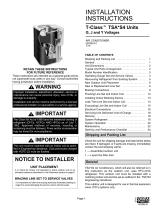
Page 15 of 21507919-01 Issue 1946
Delay Mode
The defrost system has a eld-selectable function to
reduce occasional sounds that may occur while the unit is
cycling in and out of the defrost mode. When a jumper is
installed on the DELAY pins, the compressor will be cycled
o for 30 seconds going in and out of the defrost mode.
Units are shipped with jumper installed on DELAY pins.
NOTE: The 30 second compressor delay feature (known
as the quiet shift) must be deactivated during any unit
performance testing. The feature is deactivated by
removing the jumper located on the compressor delay pins
on the control board mounted inside the unit control box.
This feature is optional for the homeowner, but may impact
testing performance.
Defrost Operation
The defrost control system has three basic operational
modes: normal, calibration, and defrost.
• Normal Mode—The demand defrost system monitors
the O line, to determine the system operating mode
(heat/cool), outdoor ambient temperature, coil
temperature (outdoor coil) and compressor run time to
determine when a defrost cycle is required.
• Calibration Mode—The board is considered
uncalibrated when power is applied to the board,
after cool mode operation, or if the coil temperature
exceeds the termination temperature when it is in heat
mode.
Calibration of the board occurs after a defrost cycle
to ensure that there is no ice on the coil. During
calibration, the temperature of both the coil and
the ambient sensor are measured to establish the
temperature dierential which is required to allow a
defrost cycle.
• Defrost Mode—The following paragraphs provide a
detailed description of the defrost system operation.
Defrost Cycles
The control board initiates a defrost cycle based on either
frost detection or time.
• Frost Detection—If the compressor runs longer than
30 minutes and the actual dierence between the
clear coil and frosted coil temperatures exceeds the
maximum dierence allowed by the control, a defrost
cycle will be initiated.
IMPORTANT - The control board will allow a greater
accumulation of frost and will initiate fewer defrost
cycles than a time/ temperature defrost system.
• Time—If 6 hours of heating mode compressor run
time has elapsed since the last defrost cycle while the
coil temperature remains below 35°F (2°C), the control
board will initiate a defrost cycle.
Actuation
When the reversing valve is de-energized, the Y1 circuit is
energized, and the coil temperature is below 35°F (2°C),
the board logs the compressor run time. If the board is not
calibrated, a defrost cycle will be initiated after 30 minutes
of heating mode compressor run time. The control will
attempt to self-calibrate after this (and all other) defrost
cycle(s).
Calibration success depends on stable system
temperatures during the 20-minute calibration period. If
the board fails to calibrate, another defrost cycle will be
initiated after 45 minutes of heating mode compressor
run time. Once the control board is calibrated, it initiates
a demand defrost cycle when the dierence between
the clear coil and frosted coil temperatures exceeds the
maximum dierence allowed by the control OR after 6
hours of heating mode compressor run time has been
logged since the last defrost cycle.
NOTE: If ambient or coil fault is detected, the board will not
execute the “TEST” mode.
Termination
The defrost cycle ends when the coil temperature exceeds
the termination temperature or after 14 minutes of defrost
operation. If the defrost is terminated by the 14-minute
timer, another defrost cycle will be initiated after 30 minutes
of run time.
Control Board Diagnostics and Test Mode
Control Board Diagnostics
See control board diagnostic LED table (Table 6) to
determine control board operational conditions and to
diagnose cause and solution to problems.
Test Mode
When Y1 is energized and 24V power is being applied
to the board, a test cycle can be initiated by placing the
termination temperature jumper across the “Test” pins for
2 to 5 seconds. If the jumper remains across the “Test” pins
longer than 5 seconds, the control will ignore the test pins
and revert to normal operation. The jumper will initiate one
cycle per test.
Enter the “TEST” mode by placing a shunt (jumper) across
the “TEST” pins on the board after power-up. (The “TEST”
pins are ignored and the test function is locked out if the
shunt is applied on the “TEST” pins before power-up). Board
timings are reduced, the low pressure switch is ignored
and the board will clear any active lockout condition.
Each test pin shorting will result in one test event.
For each “TEST” the shunt (jumper) must be removed for
at least 1 second and reapplied. Refer to ow chart for
“TEST” operation.
NOTE: The Y1 input must be active (ON) and the “O” room
thermostat terminal into board must be inactive.





















